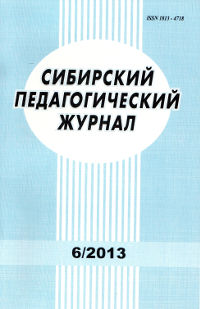Specifics of Relationship of Indicators of Students' OFP & Number of Activities on “Physical Cultureˮ Subject
1. Bolotin, K. A., Nizametdinova, Z. H., 2023. Physical culture and sport as factors of economic development of the Russian Federation. Scientific notes of the University named after P. F. Lesgaft, no. 5(219), pp. 92–94. DOI: 10.34835/issn.2308-1961.2023.05.p92-95. (In Russ., abstract in Eng.).
2. Korolev, V. G., Bardushkin, V. V., 2011. Physical preparedness of young male students of junior courses and its dynamics in educational process in technical university. Physical education: upbringing, education, training, no. 1, pp. 58–62. (In Russ., abstract in Eng.)
3. Zaitseva, N. V., 2020. Dynamics of the main indicators of physical fitness of students of North-eastern state university depending on the standard of training. Scientific notes of the University named after P. F. Lesgaft, no. 12(190), pp. 69–74. DOI: 10.34835/issn.2308-1961.2020.12.p69-74. (In Russ., abstract in Eng.)
4. Kopeikina, E. N., Kondakov, V. L., Voloshina, L. N., Bocharova, V. I., 2023. Assessment of the volume of students’ motor activity in modern conditions. Physical Culture. Sport. Tourism. Motor Recreation, no. 8(3), pp. 106–112. DOI: 10.47475/2500-0365-2023-8-3-106-112. (In Russ., abstract in Eng.)
5. Rybachuk, N. A., 2023. A new vision of the system of physical education in the conditions of education. Physical Culture. Sport. Tourism. Motor Recreation, no. 8 (3), pp. 5–12. DOI: 10.47475/2500-0365-2023-8-3-5-12. (In Russ., abstract in Eng.)
6. Garcia-Alvarez, D., Faubel, R., 2020. Strategies and Measurement Tools in Physical Activity Promotion Interventions in the Univer sity Setting. A Systematic Review. International Journal of Environmental Research and Public Health, no. 17 (18), р. 15.
7. Barancev, S. A., Chicherin, V. P., Siverkina, T. E., Kabanova, I. A., 2022. The relation between general physical fitness of 1–3 year university students and the number of physical education lessons in a semester. Human. Sport. Medicine, no. 22(2), pp. 108–119. DOI: 10.14529/hsm220213. (In Russ., abstract in Eng.)
8. Samsonenko, I. V., 2015. Analysis of the state of health of higher school students. Scientific notes of the University named after P. F. Lesgaft, no. 11(129), pp. 229–232. (In Russ., abstract in Eng.)
9. Lucenko, S. Ja., 2017. The standard in running for 1000 meters as one of the indicators of the health of students. Baltic State Fishing Fleet Academy: Psychological and pedagogical sciences, no. 3(41), pp. 164–168. (In Russ., abstract in Eng.).
10. Torkhov, A. S., Krymov, A. N., Gavrilitsa, A. A., Anisimova, A. Yu., 2021. Dynamics of indicators of physical fitness of students of the medical academy entering the first year. Physical Culture and Health, no. 2, pp. 105–109. DOI: 10.47438/1999-3455_2021_2_105. (In Russ., abstract in Eng.)
11. Krivoschekova, O., Sumina, V., Krylova, T., 2020. Analysis of the dynamics of physical fitness of university students. Electronic scientific and methodological journal of Omsk State Agrarian University, no. 4 (23), p. 20. (In Russ., abstract in Eng.)
12. Sumak, E. N., Kostsova, E. V., Khanzhina, O. A., Izarovskaia, I. V., Perelman, E. B., Nenashev, A. I. An individual approach to physical education at university. Human. Sport. Medicine, no. 24 (3), pp. 142–151. DOI: 10.47475/2500-0365-2023-18117. (In Russ., abstract in Eng.)
13. Ivanov, V. D., Marandykina, O. V., 2023. Motion state as an important factor in health promotion and preservation of students. Physical Culture. Sport. Tourism. Motor Recreation, no. 8(1), pp. 113–119. DOI: 10.47475/2500-0365-2023-18117. (In Russ., abstract in Eng.)
14. Zhukova, T. V., Gorbacheva, N. A., Haragurgieva, I. M. [et al.], 2018. Health of students as a prognostic model of nation’s health. Public health and habitat – ZniSO, no. 4 (301), pp. 36–41. DOI: 10.35627/2219-5238/2018-301-4-36-41. (In Russ., abstract in Eng.)
15. Osipov, A. Ju., Kadomceva, E. M., Lepilina, T. V. [et al.], 2015. The search for effective methods preservation and promotion of health of students in physical education in universities. In the world of scientific discoveries, no. 3-8(63), pp. 3557–3573. DOI: 10.12731/wsd-2015-3.8-5. (In Russ., abstract in Eng.)
16. Irkhina, I. V., Voronkov, A. V., Ospishchev, V. P., Grebtsova, A. A., 2022. Physical education department students: year to year physical progress tests and analysis. Theory and Practice of Physical Culture, no. 3, pp. 58–61. (In Russ., abstract in Eng.)
17. Blinkov, S. N., 2019. Dynamics of physical fitness of students of Samara agricultural university from 2015 to 2018. Innovative achievements of science and technology of the agroindustrial complex: Collection of scientific papers of the International Scientific and Practical Conference, Samara, December 11-12, 2019, Samara: RIO Samara State Agrarian University, pp. 114–117. (In Russ.)
18. Barantsev, S. A., Chicherin, V. P., Barannikov, V. V., Zezyulin, F. M., 2024. Dependence of the development of endurance on the number of practical exercises in the discipline “Physical education” among 1st and 2nd year students. Scientific notes of the University named after P. F. Lesgaft, no. 9(235), pp. 25–29. (In Russ., abstract in Eng.)
19. Barantsev, S. A., Siverkina, T. E., Khromov, S. E., 2010. Standards for assessing changes in the indicators of general physical fitness of first-year students during the academic year. Almanac “New research”, no. 3(24), pp. 87–96. (In Russ., abstract in Eng.)




